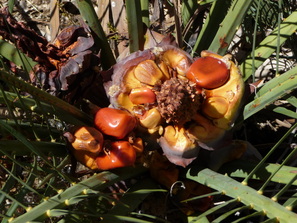Bush tucker: Zamia (macrozamia riedlei)

Bush tucker: Zamia (macrozamia riedlei)
Posted on
The Zamia plant are as common as a politician on polling day, but decidedly more useful. If you have ever been walking through the south west of Western Australia, you would have definitely seen one of these guys. Right next to the zamia palm you would probably have seen me dressed in my dorky hiking gear staring lovingly at this marvellous little plant.
Prior to settlement, the Zamia palm was an important source of food for the aboriginal people of the South West. Over summer the plant produces what looks like a pineapple and come March the nuts ripen into a deep red colour similar to capsicum. Aboriginal people would pulp the nuts (see photo) and turn it into a pancake type thing which they would cook on a rock next to the fire. By all reports is that it taste just like chicken… only joking. Apparently it has a bread like flavour with a hint of coconut. I have also heard that Aboriginal people would use it for a porridge as well but I am not so sure about that. Raw zamia mush doesn’t sound very appetising especially without my cinnamon LSA mix.
Getting hungry yet for some Zamia? Well I hope you can wait a bit, because this is far from fast food. The Zamia nut is toxic and needs to be soaked in water for at least a week to leach out all of the poison. A fact that the white settlers and their cattle knew only too well but in many cases, only too late.
Of course Aboriginal people would use the poison – not to poison the setters but to stun fish in their fish traps. It just so happens that the mullet are running in the Swan river in March as well. Isn’t nature marvellous?
There are many more interesting things to learn about the zamia palm. It has many more uses and a really amazing pollination process… but perhaps these things are best learnt out on the trails.
Happy hiking,
Simon



